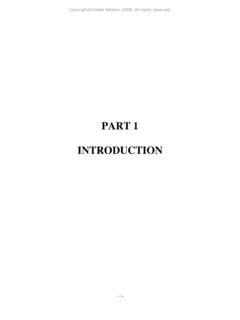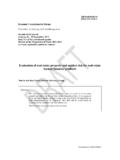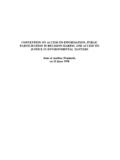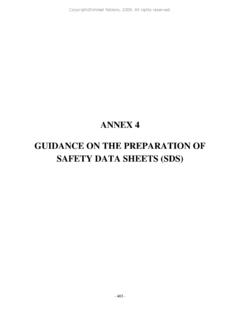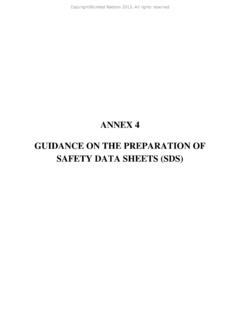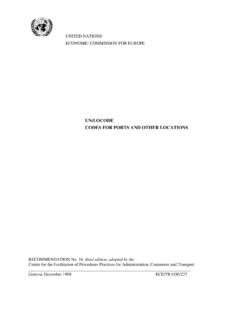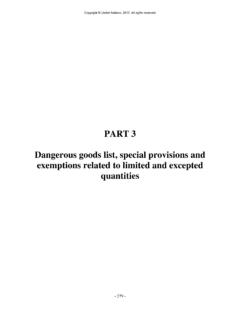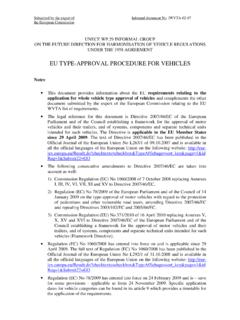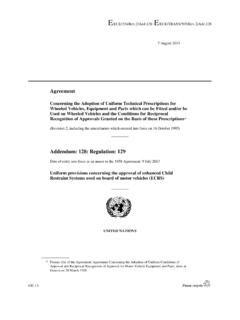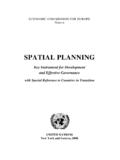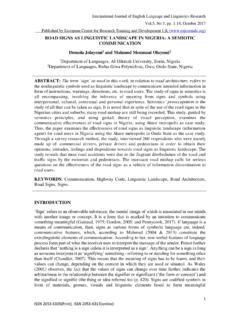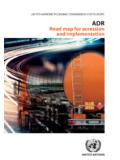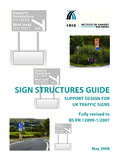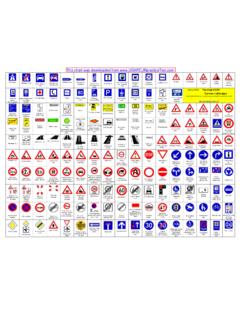Transcription of Cover page 1 - UNECE
1 Cover page 1 Cover page 2 Disclaimer The present publication, which contains consolidated versions of the vienna convention on road Signs and Signals, the european Agreement supplementing the convention and its additional Protocol, has been prepared for information and reference purposes. It is not a legal document and is not intended to substitute the official legal texts of the convention , the european Agreement, its additional Protocol and the amendments to them. The symbols of the official texts are provided on page viii of the present publication. ECE/TRANS/196 UNITED NATIONS PUBLICATION Sales No. ISBN: 978-92-1-116973-7 iii Foreword As road users in our everyday life, we tend to take for granted the system of road traffic rules, signs and signals, which has been developed to regulate road traffic and avoid accidents. However, a considerable amount of research and planning has gone into this system, which has been developed gradually since the start of motorization in the early 1900s and more intensively since the Second World War.
2 Efficient, safe and sustainable road traffic requires adequate regulations for the construction of roads, for the manufacturing of vehicles and for traffic on the roads. Given the trans-frontier dimension of road traffic, it is essential that such regulations be internationally harmonized on the basis of internationally agreed regulations. The UNECE has, since its creation in 1947, developed international regulations on the various components of road traffic: the road , the vehicle and road users. Incorporated into legally binding agreements and conventions, those regulations are regularly updated in order to keep them up to best practices and the best available technologies. The implementation in UNECE countries of these agreements and conventions has greatly contributed to lowering the number of people killed on UNECE roads despite a sharp increase in road traffic. However, while this evolution is encouraging, there is no room for complacency.
3 In 2004, more than 140,000 people lost their lives and about 5 million more were injured on the road in the UNECE region. In the whole world, figures are daunting: about million people die and between 20 to 40 million more are injured every year in road accidents, of which about 80% in low- and middle-income countries. In addition to personal tragedies and tremendous human suffering, road accidents are estimated to cost to society about US$ 500 billion a year worldwide. A most basic requirement to reduce these figures drastically is to put in place appropriate road traffic legislation that is based on the relevant international conventions. In resolution A/RES/60/5, the United Nations General Assembly encouraged Member States to adhere to the UN Conventions on road Signs and Signals and on road Traffic in order to ensure a high level of road safety in their countries, and also encouraged them to strive to reduce road traffic injuries and mortality in order to achieve the Millennium Development Goals.
4 The present publication contains consolidated versions of the vienna convention on road Signs and Signals, the european Agreement supplementing the convention , and its additional Protocol, incorporating all the amendments that have been prepared and adopted by the UNECE Working Party on road Traffic Safety ( ) in order to make their safety provisions more stringent. I believe that, if applied, these legal instruments will contribute to preventing many deaths and injuries on the world s roads and I encourage all United Nations Member States that have not yet done so to adhere to and implement them as soon as possible. It is often said that time is gold. In this matter, time is also human lives. Let s act quickly to save many lives Marek Belka Executive Secretary United Nations Economic Commission for Europe v CONTENTS Page Disclaimer .. ii Foreword .. iii Historical background.
5 Vii Part I convention on road Signs and Signals, of 1968 ( vienna convention ) .. 1 Chapter I General Provisions (Articles 1 to 4) .. 3 Chapter II road Signs (Articles 5 to 22) .. 7 Chapter III Traffic Light Signals (Articles 23 to 24) .. 15 Chapter IV road Markings (Articles 25 to 30) .. 18 Chapter V Miscellaneous (Articles 31 to 36) .. 21 Chapter VI Final Provisions (Articles 37 to 48) .. 23 ANNEXES 1. road Signs .. 31 2. road Markings .. 57 Diagrams .. 63 3. Reproduction in Colour of Signs, Symbols and Panels Referred to in Annex 1 .. 83 Part II european Agreement supplementing the 1968 convention on road Signs and Signals .. 109 Text of the european Agreement .. 111 Annex to the european Agreement .. 117 Annex- Appendix (Models of road Signs).. 129 Part III Protocol on road Markings, Additional to the european Agreement Supplementing the convention on road Signs and Signals of 1968.
6 133 Text of the Protocol .. 135 Annex to the Protocol .. 141 Diagrams .. 151 Part IV List of Contracting Parties to the 1968 convention on road Signs and Signals .. xx Declarations and reservations .. xx vi CONTENTS (continued) Part V List of Contracting Parties to the european Agreement supplementing the 1968 vienna convention on road Signs and xx Declarations and reservations .. xx Part VI List of Contracting Parties to the Protocol on road Markings, Additional to the european Agreement Supplementing the convention on road Signs and Signals xx Declarations and reservations .. xx Alphabetical index of the vienna convention on road Signs and Signals, the european Agreement Supplementing the convention and its Additional Protocol .. xx vii Historical Background The origins of international legislation on road traffic may be traced back to the International convention on Motor Traffic concluded in Paris on 11 October 1909.
7 The problems of motor vehicle construction, of admission to international traffic and of signs and signals were already dealt with, as regards the essentials, in that convention . The expansion of motor vehicle traffic led to the conclusion in Paris, on 24 April 1926, of two new conventions which were intended to amend and amplify the 1909 convention : the International convention relating to road Traffic and the International convention relating to Motor Traffic. Various texts had served as a basis for these Conventions; most particularly the draft prepared by the League of Nations Special Committee of Enquiry on road Traffic, a draft by the French Government and a draft by the Swedish Government aimed mainly at the standardization of certain danger warning signs. The 1926 convention did not deal exhaustively with road signs and signals. To fill this gap, a convention concerning the Unification of road Signs was concluded in Geneva on 30 March 1931.
8 In December 1943, the States of the Two Americas, meeting under the auspices of the Pan American Union in Washington, concluded a convention on the Regulation of Inter-American Automotive Traffic. This regional convention did not deal with signs and signals. In 1948, noting that the Conventions of 1926 and 1931 were obsolete, the United Nations Economic and Social Council, by resolution 147 B (VII) of 28 August, called for a United Nations Conference on road and Motor Transport to be convened in Geneva. That Conference based its work on a draft convention prepared by the Inland Transport Committee of the United Nations Economic Commission for Europe and on the 1943 convention on the Regulation of Inter-American Automotive Traffic. The work of the Conference resulted, in 1949, in the conclusion of a convention on road Traffic and a Protocol on road Signs and Signals. The first of these instruments terminated and replaced, in relations between the Contracting States, the 1926 Conventions and the 1943 Inter-American convention .
9 The two instruments provided for a procedure enabling them to be amended without any need for calling a conference, on condition that two thirds of the Contracting States agreed. The procedure was initiated for both the convention and the Protocol, but bore fruit only in the case of the Protocol, which was amended with effect as from 22 October 1964. In 1964, the Economic and Social Council noted that the procedure for revision without convening a conference had failed so far as concerned the 1949 convention , although greater uniformity of national regulations governing road traffic and the equipment of motor vehicles was needed, and that the 1949 Protocol, too, should be amended more radically than had been possible by that procedure. By resolution 1034 (XXXVII), the Council decided that in preparation for a conference, detailed technical studies should be undertaken with a view to the preparation of a revised draft convention on road traffic and on standard technical specifications for vehicles, and also of a draft instrument on road signs and signals and on road markings.
10 It was stipulated that the regional economic commissions, in particular, should take part in that work. In the following year, after taking note of the draft texts thus prepared by the Secretary-General (E/3998 and , and E/3999 and ), the Economic and Social Council decided that a conference should be convened in order to prepare a new convention on road traffic to replace the 1949 convention , and either another convention or an optional protocol on road signs and signals (resolution 1082 (XXXIX)). viii In July 1966, the Economic and Social Council made the final arrangements for the preparation of the conference by resolution 1129 (XLI), which was to be amended the following year on certain points of detail (resolution 1203 (XLII)). More particularly, it decided that two draft conventions should be prepared as a basis for the work of the Conference ( and and and and and ), that these texts should be circulated to Governments and to international organizations concerned so that they could make, respectively, such proposals or suggestions for amendments as they deemed necessary.
